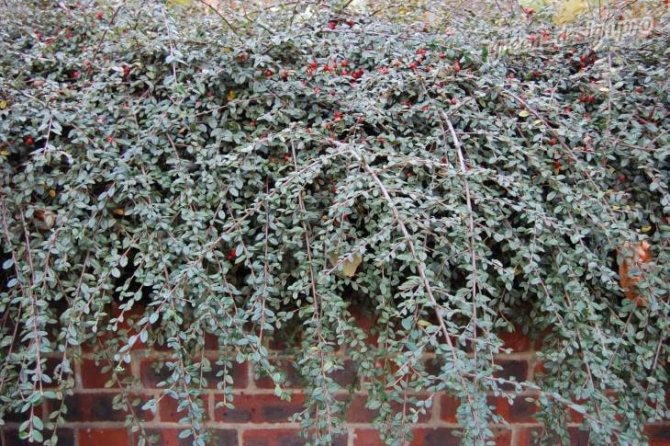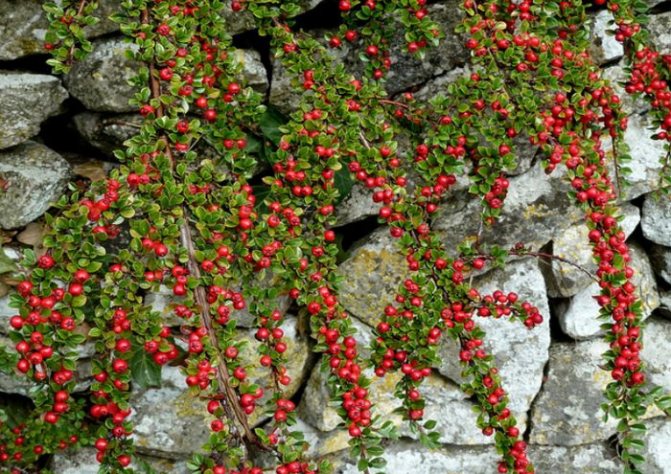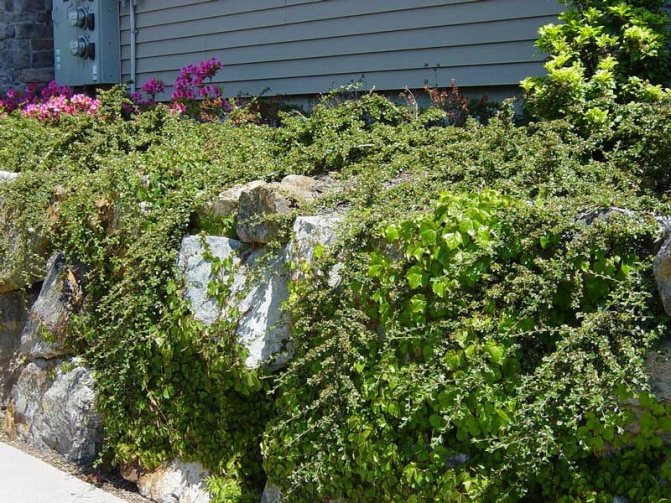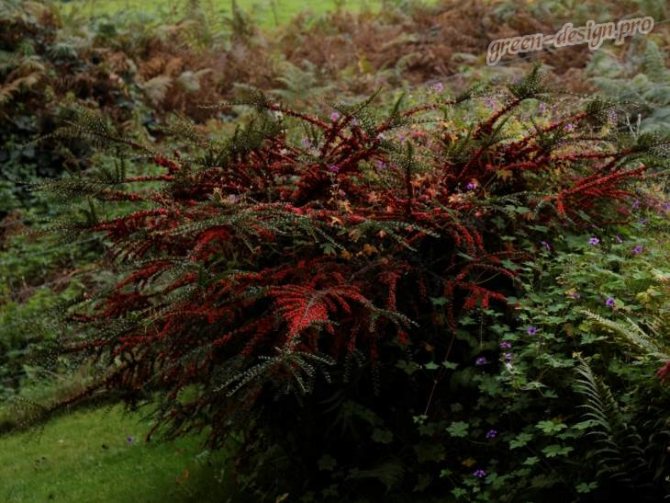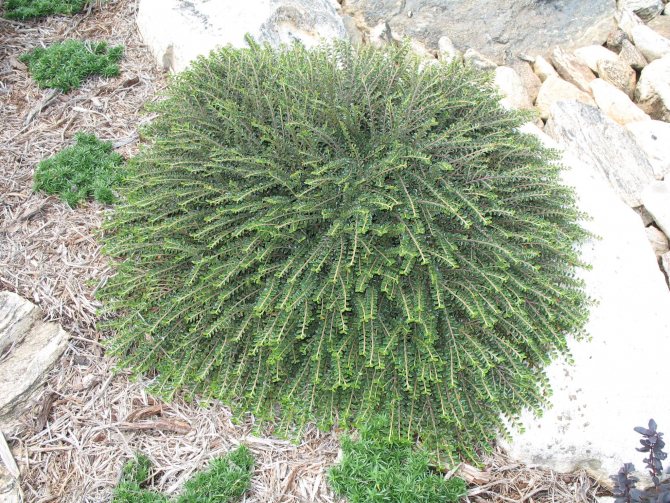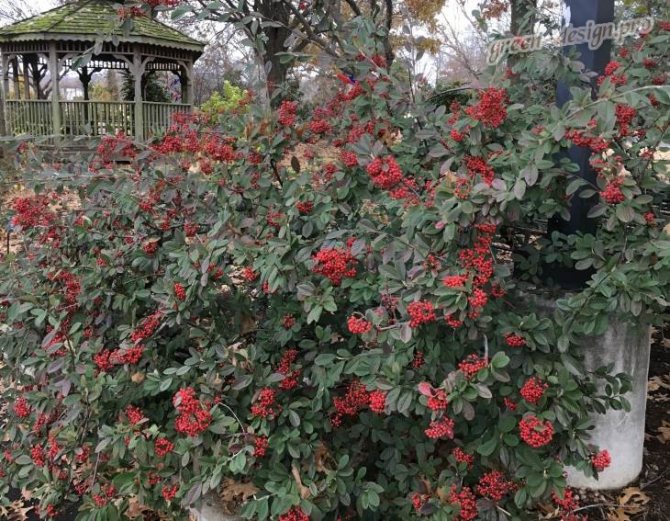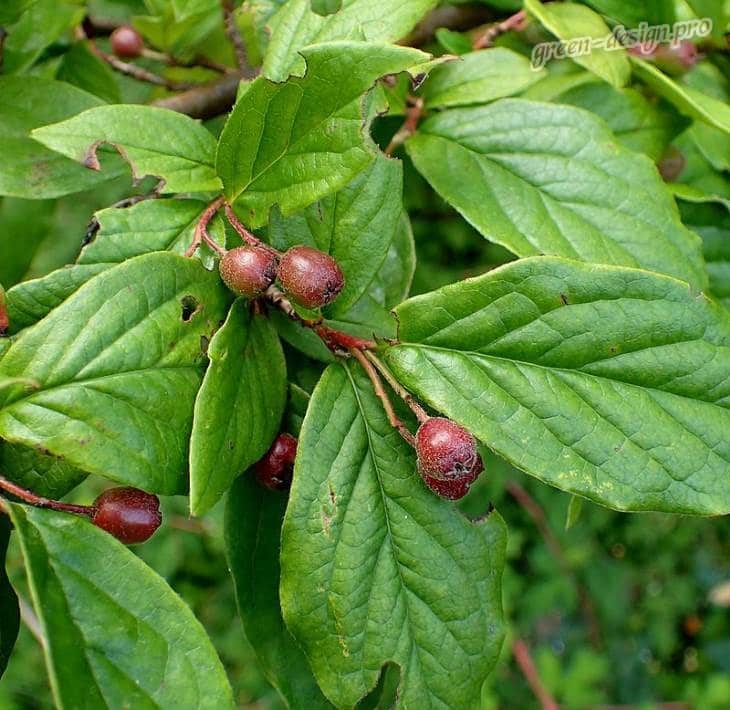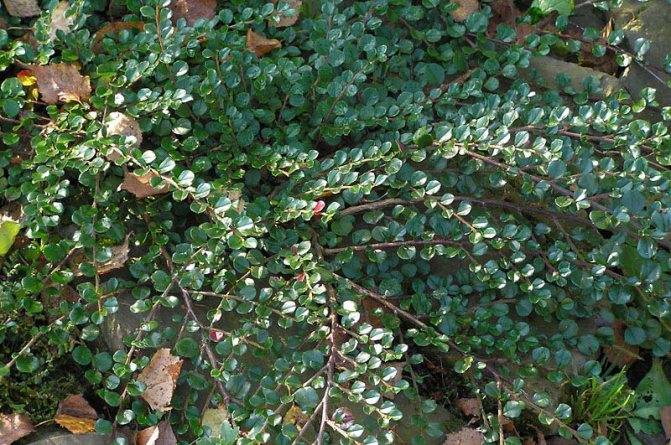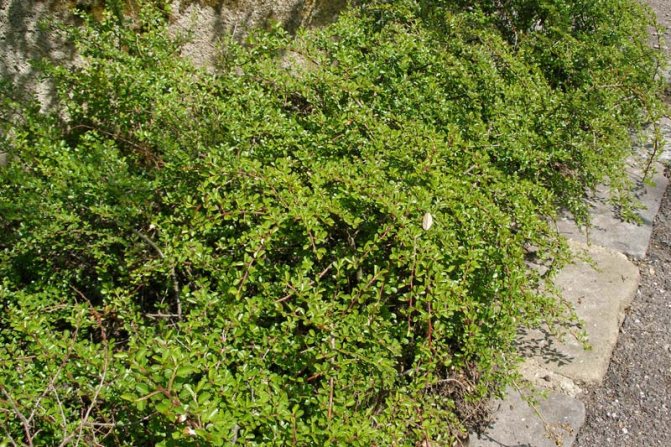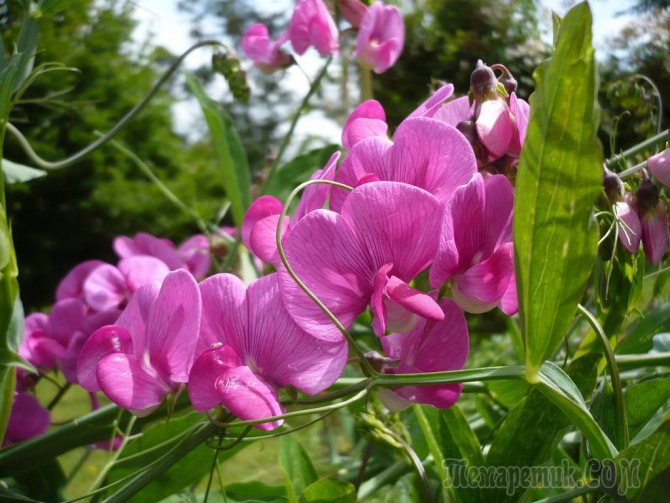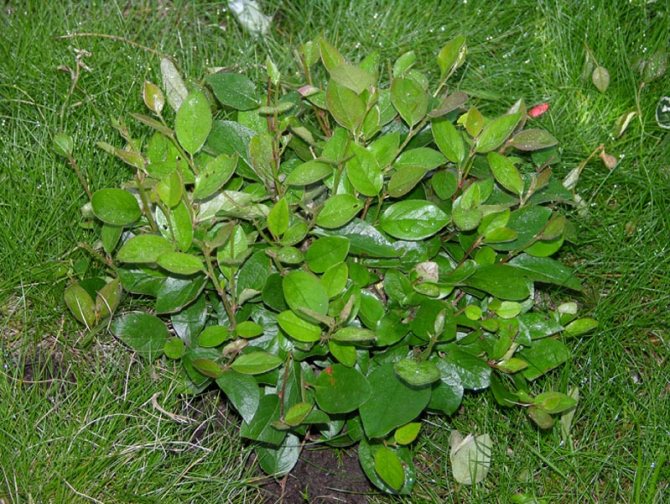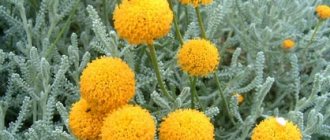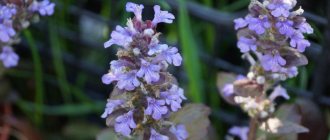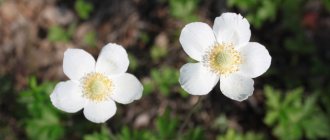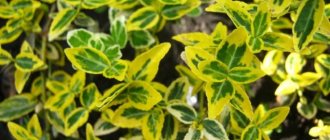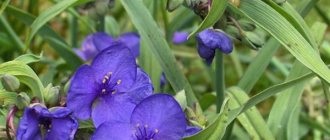You can decorate the site not only with bright perennials. Evergreen shrubs, for example, a cotoneaster from the Rosaceae family, look no less beautiful. He hails from China, but remarkably adapted to European latitudes.
Deciduous bushes are unlikely to surprise with a chic flowering, white and pink inflorescences are not so decorative. But the branches are very attractive, generously strewn with clusters of small bright red or bluish-black fruits.
There are at least a hundred species in the genus, which differ in shape and size. Therefore, a cotoneaster in landscape design can be incredibly diverse.
general information
An ornamental shrub about 50 cm high with spherical fruits is often found in urban and private gardens. Compositions using this shrub always attract attention.
Leaves
Small rounded leaves grow only up to 1.5 cm. In summer, the leaves of the horizontal cotoneaster are colored dark green.
In autumn, the shrub blazes with crimson-red tones, often with a purple hue. Against the background of fallen leaves, the cotoneaster looks great and enlivens the space.
Photo of a horizontal cotoneaster.
Flowers, fruits
Flat pinkish-red flowers give the shrub a high decorative effect. The shrub blooms in late May. The flowering period lasts about three weeks.
This ornamental shrub is quite unpretentious. The plant is not afraid of urban conditions. Exhaust gases are not particularly harmful to the cotoneaster.
The shrub tolerates drought well. The plant loves light, it can grow in partial shade, but you should not specially plant a cotoneaster under spreading trees. In an area with sufficient lighting, the plant will quickly take root and develop correctly.
For a year, the horizontal cotoneaster grows 15 cm wide and 10 cm high. With good care, the shrub will delight the eye for many years.
Care in the process of growing
Gardeners appreciate this plant for the fact that it does not require careful maintenance. It is enough to periodically water, fertilize and prepare for winter in time.
- Watering. Despite the fact that the horizontal cotoneaster is drought-resistant, it is watered regularly - once a month. During the period of heat and drought, the culture may lose its decorative properties, therefore, it is necessary to water it once every two weeks. 6-8 liters of water are poured under each bush.
- Fertilizer. When planting a horizontal cotoneaster in fertile soil, it is not necessary to fertilize it. But in order for the bushes to be lush and beautiful, top dressing is added. This procedure is carried out 3 times a year: the first time - in early spring, the second time - before flowering, and the third time - in the fall. In the spring, some gardeners use urea (30 grams of granules are diluted in 10 liters of water) or nitroammofoska (30-40 grams per 1 sq. M.). Before flowering bushes add potassium sulfate (15 grams per 1 sq. M.) Or granular superphosphate (60 grams per 1 sq. M.). In autumn, the horizontal cotoneaster is fed with potassium-phosphorus fertilizers. If the culture does not develop well, they apply slurry (1:10) or diluted bird droppings (1:15).
- Pruning. The horizontal cotoneaster grows quickly, so pruning should be done on time.Experienced gardeners in this way decorate landscapes, giving various forms to this shrub. The first time the bushes are cut in March, when the movement of the juices has not yet begun. Dry, dead branches and those that grow in an unwanted direction are sure to be removed in order to give the shrub a certain shape. The second pruning in the summer will help to better form a neat, beautiful crown. It is necessary to cut off about 1/3 of the branch that has grown in a year, in the second year after planting - ¼ part.
- Preparing for winter. Since the horizontal cotoneaster is a heat-loving plant, for the winter it must be covered with a layer of peat or dry leaves. And to protect from frost - bend the branches to the ground.
Remove weeds around the bushes and loosen the soil as needed. After each watering, gardeners are advised to mulch the soil around the shrub with a layer of peat.

The use of a cotoneaster in landscape design
A beautiful and well-kept garden is the hallmark of any private home. But is it possible for each person to run around their plot with pruners and buckets of fertilizer from bush to bush, endlessly watering, cutting, replanting everything? This question spawned the idea of lazy gardening, which says: a garden should be wonderful with little or no human intervention.
"Lazy" gardeners select the most unpretentious, but decorative plants for landscaping. One of the best shrubs for a self-sufficient garden is considered to be the Cotoneaster, from the Rosaceae family. The genus of cotoneaster counts more than 40 species, of which about ten are now used in landscape design - this is an ordinary cotoneaster, horizontal, shiny and others.
Cotoneaster grows rather slowly, is valued for its dense crown, good branching, undemanding to soil and light, resistance to dust, gas pollution, drought and frost. Growing a cotoneaster is not difficult, and it can grow in one place up to 50 years and does not require a transplant!
Small cotoneaster leaves, dark green and shiny, turn red in autumn. Moreover, some types of cotoneaster will not shed their foliage for the winter - evergreen beauties will simply dust themselves with snow.
The flowers at the cotoneaster are small, white or pink, can be collected in inflorescences, but still will not be of particular decorative value. But they will attract butterflies and bees (cotoneaster is considered a good honey plant).
However, one should not expect taste and benefit from them: many amateur gardeners unknowingly plant a cotoneaster on the site, confusing it with common dogwood (Cornus mas).
Kizil - a native of the Caucasus, is valuable for its vitamin acidic fruits, and the fruits of the cotoneaster are almost tasteless.
Due to its strong branching, dense foliage and unpretentiousness, the cotoneaster is indispensable for planting in a low hedge or curb. A hedge made from a brilliant cotoneaster or an ordinary cotoneaster calmly withstands the merciless urban conditions, so it can be found in parks, squares and along highways.
Cotoneaster hedge
Slow growth allows the cotoneaster to be one of the best plants for topiary cutting. The most popular topiary forms - balls, cubes, hemispherical pillows - can be formed by any summer resident, subject to certain rules.
The smallest cotoneaster, such as Dammer's cotoneaster, is used to create a shrub lawn. A lawn made of shrubs effectively replaces an ordinary lawn in problem areas of the garden - under trees, on relief differences (slopes, slopes) and in other areas that are difficult to access for a lawn mower.
The cotoneaster looks great in both single and group plantings.
Landscape designers note that these plants are especially well combined with conifers. Low types can be used in rock gardens and rockeries.
Cotoneaster bushes along the path
Landing: timing and technology
Like any deciduous shrub, it is preferable to plant the cotoneaster in the spring, when the buds swell, but before the foliage blooms. This happens at different times in each region. If you live in a warm region, you can safely plant a cotoneaster in the fall, at the time of the beginning of the massive leaf fall of trees.
Such a tight planting time is necessary for the normal survival of seedlings with an open root system or seedlings dug out with a lump of earth. If you purchased a seedling with a closed root system (in a pot), plant it even in the summer, but you will need to plant it on a cool, cloudy day. The optimum age for seedlings is 2 to 4 years.
The place for landing can be any, because the cotoneaster tolerates shading. Although its decorative qualities are best manifested in a sunny area.


As mentioned above, the cotoneaster is not picky about the composition of the soil, but the introduction of fresh fertile soil with 200 grams of lime into the pit during planting will significantly improve the life of the bush. During planting, it is important to ensure that the root collar is not above or below the soil level, otherwise the plant will die.
The rest of the procedures are standard: light compaction of the soil after planting, abundant watering, mulching with peat chips, spraying with Zircon to reduce stress ...
How to care for a cotoneaster
Caring for a cotoneaster is extremely simple. Usually, it is not cared for at all after the seedling has finally taken root. You can limit yourself to watering the bush during a drought and pruning dead branches.
Cleaning is carried out with a stream of water from a hose to remove dust and small debris. Forming pruning of the cotoneaster is carried out in the spring before the leaves bloom and no more than a third of the length of the shoots.
The cotoneaster is fed according to the usual scheme: in the spring - with any nitrogen fertilizer (urea, ammonium nitrate, etc.), and before flowering - with potassium-phosphoric fertilizer (potassium sulfate, superphosphate). The consumption of your chosen fertilizer will be indicated on the package. Instead of potash-phosphorus fertilizer, wood ash can be used. The rate of its introduction is 3 glasses per 1 m2 of soil.


Diseases and pests of the cotoneaster
The cotoneaster rarely gets sick, because it is resistant to viral and bacterial infections.
Sometimes it can be struck by Fusarium, a fungal infection that is activated by high soil moisture and affects the roots and the lower part of the stem.
Fusarium on a cotoneaster can be dealt with by removing damaged tissue and treating the plant with fungicides. In order not to face this infection, it is advisable not to forget about drainage when planting and periodically loosen the soil.
If you noticed the enemy in time, you can limit yourself to treating the bush with a decoction of yarrow, tobacco, marigolds or a soap-ash solution. And you will have to repeat the treatment 3-4 times with an interval of 5-6 days.
If you see that the entire bush is covered with pests from top to bottom, it is better to use powerful insecticides (Aktellik, Aktara, etc.) without delay.
How easy it is to propagate a cotoneaster
Reproduction of cotoneaster is possible in the following ways:
- seeds;
- cuttings;
- layering;
- dividing the bush.
The first method is the longest, most dreary and unreliable. The germination of cotoneaster seeds, even after special treatment, is very low.
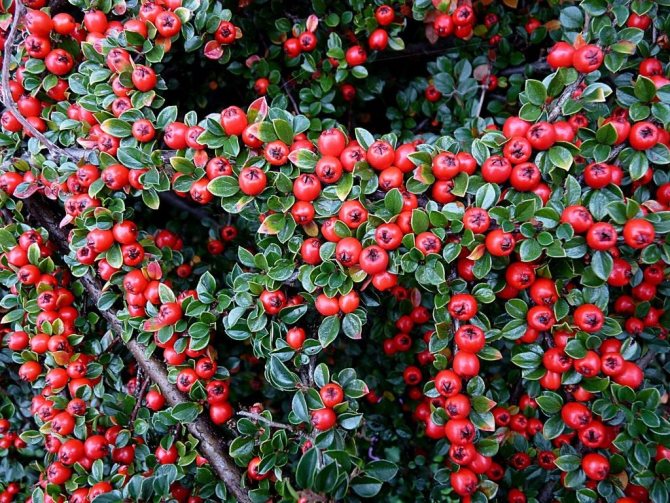

Seeds extracted from cotoneaster fruits are checked for quality in a vat of water (empty seeds should float), and then sent for stratification (aging in a humid environment at low temperatures) to improve germination.
In the spring, after the end of stratification, they can be etched with fungicides, treated with "Zircon", but still there will be few shoots - a maximum of 60%.
We suggest you familiarize yourself with: Growing hibiscus in the open field
Before planting the cuttings in a nutrient mixture of peat and sand, it is recommended to put them in water with any stimulant of root formation (for example, "Kornevin").
It has been noticed that rooting occurs better at high humidity, so many gardeners construct shelters made of polyethylene or plastic bottles for cotoneaster cuttings.
The fourth method - dividing the bush - is effective for reproduction of old bush. This is the fastest way. It is possible to carry out reproduction by dividing the bush not all season, but only at a time suitable for planting plants with an open root system (see above).
Brilliant cotoneaster (Cotoneaster lucidus).
Growing area: Natural homeland - Eastern Siberia, but in culture it can grow in Western Siberia and Europe. Size and shape of the bush: Bush 2, less often 3 m high, round, with upright shoots.
Decorative qualities: The foliage is dense, glossy, dark green. At the end of May, pink flowers bloom near the cotoneaster. In autumn, the foliage turns red and falls, but round and shiny black fruits hang on the bush until November.
Requirements for environmental conditions: Does not have any special requirements for growing (see basic requirements above). Differs in high winter hardiness and frost resistance.
The brilliant cotoneaster strongly resembles another species - the black cotoneaster (Cotoneaster melanocarpus). The latter is distinguished by larger leaves, loose inflorescences, better winter hardiness and edibility of its fruits.
Horizontal cotoneaster (Cotoneaster horizontalis)
Growth area: The homeland of this species is China, where it grows on the slopes of the mountains. From the end of the nineteenth century, gardeners began to actively use the horizontal cotoneaster in the landscape design of European gardens. By the way, the shrub will take root well in Siberia.
Ornamental qualities: It is an evergreen species with small leathery leaves arranged in sequence with mathematical precision. In May, bloom begins (bright pink flowers), which can be observed for three weeks, but the flowers are not very decorative. But by September, the bush will glow with crimson and medium-sized, but numerous, bright red fruits will ripen, which will not fall off until spring.
Reproduction
A perennial plant is bred in several ways. Vegetative methods are considered productive and less laborious, since the generative method (using seeds) does not guarantee the preservation of varietal qualities. It is used for breeding typical species. Breeders use it to develop new varieties and hybrids.
Seeds
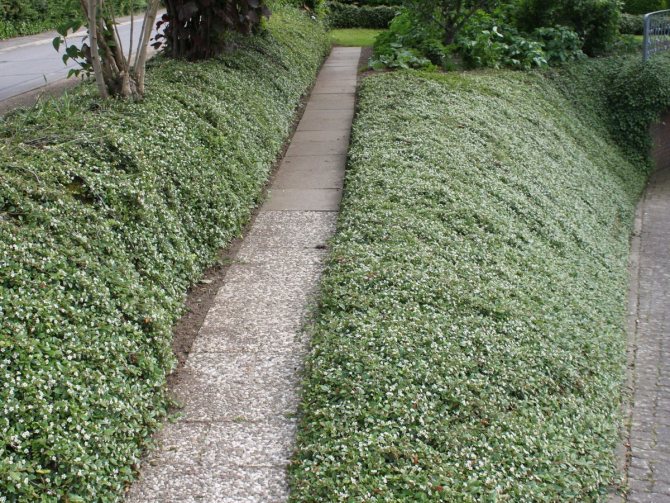

The seed has poor germination. Even when using self-collected seeds extracted from ripe fruits, it does not exceed 60%. The resulting seed is soaked in water to remove substandard ones - they will remain floating on the surface. Then the germinating seed is sent for stratification (being at low temperatures in a humid environment). In the spring, it is pickled with fungicides and sown. Seedlings with the organization of greenhouse conditions appear only after three months.
Cuttings
An easy-to-use technique that is used at the beginning of summer. Step-by-step instruction:
- Cuttings are cut (apical shoots).
- Prepare a substrate of sand and peat in equal parts.
- Cuttings are treated with a growth stimulant to accelerate rooting.
- Planting material is placed in a wet soil mixture and covered with cut plastic bottles.
- The latter are removed for a short time before rooting - for moisturizing and airing.
Varieties
Category: Useful information
Among the several methods of breeding a horizontal cotoneaster among gardeners, the most popular method is cuttings.
Features:
- a good stalk is harvested at the end of July;
- planting nutrient mixture consists of peat and sand. Ratio 1: 1;
- cuttings root well under the film.


Seeds of cotoneaster reproduce worse. Germination rate is within 60%.
Features of the method:
- seeds are poured into a container with water, the floating ones are taken up. This planting material is unusable;
- good quality seeds can be sown, but they do not germinate well. The reason is a long period of rest;
- experts recommend stratifying them and sowing only next fall.
The horizontal cotoneaster is the most popular and valuable species grown in gardens for a long time. This plant has several varieties that have their own unique characteristics. The most famous of them:
- Common cotoneaster. This variety is distinguished by the shiny surface of the leaves and the black color of the fruits.
- Multi-flowered is a shrub that grows up to 3 meters. Light green leaves change color to crimson in autumn. Flowers are collected in corymbose inflorescences.
- Appressed - a variety with low-lying branches. The height of the bush is about one and a half meters.
- Chokeberry. A feature of this cotoneaster is the black fruit. The bush blooms within one month, starting from the 5th year of life.
- Horizontal shiny - one of the most popular types, up to 2 meters high. The leaves of this plant are green with a shiny, silvery surface.
- Variegatus is an evergreen low shrub with creamy leaves.
- Coral extravaganza - characterized by a spreading crown. Dark green leaves turn red in autumn. Small flowers with pinkish petals. The fruits ripen in early autumn and have a shiny, smooth surface.
The red-fruited variety differs little from the black-fruited one. The only difference is in the color of the fruit.
It is not difficult to dissolve a horizontal cotoneaster on your own. Even the most inexperienced gardeners can do this. Reproduction of a plant is possible in several ways: by cuttings, seeds, layering and dividing the bush. Each option has its own characteristics, which must be taken into account.
Seed propagation is used very rarely, more often for industrial cultivation, because the seeds of the horizontal variegated cotoneaster do not germinate well. The sprouts give only 60% of the seeds.


After waiting for the fruits to fully ripen, somewhere in mid-October, they are plucked, peeled and the seeds are removed, which are placed in water to select healthy and high-quality ones. Good seeds sink to the bottom. The ones that come up will be of no use, so they should be thrown away.
To increase the number of seedlings, seeds must be stratified. Mix dry seeds with peat and sand, moisten a little and place in cold (t - 0 ° C) until spring.
When the soil warms up in the spring, the seeds are planted in open ground. Since the germination of seeds is not very high, it is better to take them with a reserve.
Reproduction by cuttings is more effective, therefore it is more common. However, this method is not suitable for all types of cotoneaster, as the cuttings do not get along well.
Breeding material is harvested from May to July. To do this, choose strong young shoots on an adult bush. Cuttings of 15 cm are cut from them. Only two upper leaves are left on the handle, cutting them off a little, the rest are removed and placed in a container with a growth stimulator for a day.
It is necessary to root the cotoneaster cuttings in the previously loosened soil, consisting of peat and sand. Place them at an angle of 45 ° C. Sprinkle abundantly with water. Cover the top with a cut plastic bottle. The plantings are periodically aired, removing the shelter to prevent the death of the cuttings.
The first roots will appear in a month. When the leaves appear, the shelter is removed. Planting material for the winter is well covered with foliage and spruce branches. Young plants are planted in a permanent place the following spring, when the cuttings have sufficient root growth.
Reproduction by dividing the bush guarantees a 100% result. The division is carried out in spring or autumn.Overgrown adult bushes must be periodically divided, as they become shapeless. Using a sharp shovel, they remove the bush and divide its rhizome into parts, which are immediately planted in the prepared soil and watered well.
Another simple vegetative propagation method for a plant is horizontal layering. When the soil warms up in the spring, you should choose healthy, strong shoots on the bush. Dig grooves under them and fill them with peat and sand. Bend the selected branches to the grooves and fix them with wire. Sprinkle with prepared soil mixture on top. Only the tops of the shoots should remain on the surface.


Ornamental plants create coziness, give uniqueness to the garden and are an excellent option for landscaping the site. The horizontal cotoneaster is an unpretentious plant in planting and maintenance, which is ideal for creating a garden composition.
This plant reproduces with seeds, cuttings, cuttings and grafts. The most ineffective way is seed propagation. They usually have a very low germination rate, no more than 60%.
The selection of seeds suitable for growing a plant is made as follows: you need to put them in a container with water and mix slightly. Those that come up - discard, and the rest can be safely sown.
But it should be borne in mind that the seeds of the horizontal cotoneaster have a long dormant period and one should not expect quick shoots, since they germinate very difficult. You need to sow seeds in the ground in the fall.
The most successful breeding method is with green cuttings.
They need to be covered with plastic wrap, and then you can get a high percentage of rooting. In order for the breeding process to be more successful, it is recommended to take the following mixture: peat and sand in equal amounts.
Cuttings should be planted in the second half of July. Reproduction by layering is also very effective, but in practice, most often gardeners use cuttings.
Cotoneaster and dogwood are completely different plants, which should be immediately understood by a novice gardener. If the dogwood is most often grown for the sake of berries (although the plants themselves are very beautiful), the berries in the cotoneaster are inedible, this is an ornamental plant.
We suggest that you familiarize yourself with: How to get rid of bedbugs using folk methods
What is a cotoneaster
The wild cotoneaster, belonging to the Rosaceae family, is mainly found in relatively warm regions, both in Eurasia and America. But many species are so hardy that they can be planted in the north of Siberia. In addition, they are distinguished by their extraordinary drought resistance, which is another advantage when using the cotoneaster in ornamental plant growing.
The cotoneaster normally reacts to gas pollution and dust from cities, does not require highly fertile soil, and easily tolerates shading. It practically does not get sick, but sometimes it is attacked by pests. Easily reproduces by all methods known for shrubs.
Most cotoneaster species grow in the form of low bushes, almost all shed their foliage for the winter, but there are also evergreen varieties. Very durable: over 50 years of growth. Bushes can be erect or creeping, they are densely covered with small leaves, usually ovoid, dark green in color, sometimes with stripes or patterns. In the fall, the foliage gradually turns red, so the cotoneaster is beautiful at this time of the year.
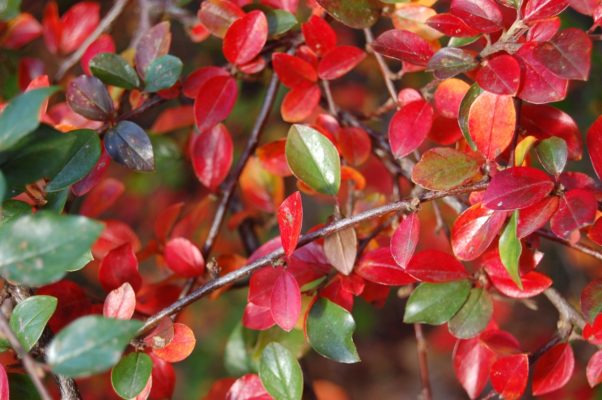

In the autumn, red leaves begin to appear on the bushes, and later they all turn purple
Inflorescences, raceme or corymbose, contain many small flowers, in most cases - white or pink. The fruits are apple-shaped, small, at first they have a green color, and in the process of ripening they become orange, red or almost black: the color of the fruits depends on the type and variety of cotoneaster.
Types of cotoneaster
There are many types of cotoneaster, but within each species the number of varieties is small. For example, in the State Register of the Russian Federation there is generally no section dedicated to this culture. The greatest frost resistance and pickiness, allowing them to be used in most regions of our country, are characterized by three types: brilliant, black-fruited and whole-edged cotoneaster. The horizontal cotoneaster, willow cotoneaster and Dammer cotoneaster are also of great interest.
The cotoneaster is propagated both by seeds and vegetatively. Vegetative propagation is easier and more common, and sometimes adult bushes can even be dug out and divided into parts.
Reproduction of cotoneaster by cuttings is carried out in the same way as propagation of, for example, currants or chokeberry. Both lignified cuttings and green ones are used. With lignified, the process is much easier. After the first frost, it is enough to cut the cuttings from the one-year lateral shoots, and in the spring to plant them in loose moist soil.
Green cuttings are cut closer to the middle of summer, in early July. They are necessarily treated in solutions of growth stimulants, after which they are planted in a mixture of peat and sand: either in a box, or in a garden bed. Until the end of the season, cuttings should be kept in moist soil and moist air. Therefore, they are covered, for example, with half a plastic bottle, and make sure that it is wet under it, but the cuttings are not stifled (for the first time, you can just put plastic bags on them). If all goes well, the small seedlings will be ready by spring.
Landing rules
The planting time of the horizontal cotoneaster depends on the selected seedling. If it has a closed root system, it can be planted anytime from spring to August. A seedling with open roots in open ground can be planted in April - May or September - October.
For planting, prepare pits with a size corresponding to the root system of the seedling. Given that the crown of the cotoneaster grows strongly, a distance of about two meters should be left between the seedlings.
At the bottom of the pit, a drainage layer is made using broken brick, crushed stone or gravel with a layer of 10-20 cm. Then a little soil mixture is poured.
A sprout with a closed root system is carefully removed from the container and placed in a planting pit, without shaking off the soil from the roots. If the roots are open, the seedling can be lowered directly onto the drainage layer.
Read also: Tomato figs pink, reviews, characteristics of the variety, features of care
Next, the plant is covered so that the root collar is flush with the surface, and the soil is well watered.
Cotoneaster horizontal Coral extravaganza
The horizontal cotoneaster cannot boast of the splendor of its foliage, and its flowers are also not highly decorative, but it is a priority among many varieties of creeping shrubs. It is actively used by landscape designers to give the garden a more decorative look.
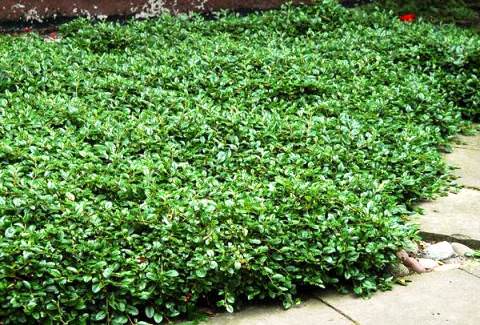

Thus, you can create various hedges, alpine slides and much more, from small fences to the embodiment of fantasy to the fullest! After all, a huge variety of types and varieties of cotoneaster allows you to bring the idea to life as much as possible, while you do not need to make huge investments in this.
Especially, one of the most frost-resistant and unpretentious species of all abundance should be considered, which is very important in our harsh climate, namely, this is a horizontal cotoneaster.
The origin of this plant originates from China, there, on the mountains and slopes, it is not rare. It is the horizontal cotoneaster that is the most elegant representative of the family, and is as unpretentious as everyone else.
Its name itself, in a sense, gives a small characteristic of it - you can immediately understand that this shrub is creeping.Most of the fellows of this species are deciduous plants, and besides that, it is also evergreen, which is undoubtedly a plus.
The shrub is distinguished by its compactness and rapid development in growth, but it rarely happens when the height exceeds 55 cm.
Dense, pinnate-branched shoots that look like a fish ridge are located practically on the same plane and can spread over an impressive width, which is about one and a half meters.
It is worth remembering! The fruits of the cotoneaster are considered non-poisonous, but it is strictly forbidden to eat them.
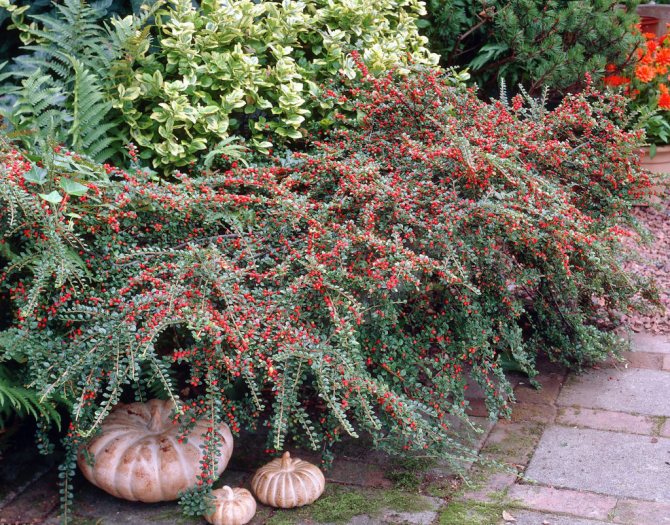

Flowering begins at the end of May and lasts for three weeks, the flowers are so small that they are almost invisible, despite their bright pink color with a shade of red, they can be single or paired.
Despite the fact that cotoneaster (and there are about 50 species) cannot boast of spectacular leaves or flowers, they are always popular with gardeners. What is the matter here?
It is that the group of these plants includes some of their creeping species.
They are very good for decorating walls, spaces between large plants, feet of garden decor elements, slopes.
When choosing varieties of this plant necessary for decorating a garden, you should pay attention to one of the most unpretentious and frost-resistant varieties - the horizontal cotoneaster (Cotoneaster horizontalis Variegatus).
Description
This plant comes from China, where it grows in abundance on the slopes of the mountains.
The horizontal cotoneaster is one of the most elegant representatives of this family.
Already in the name itself, its main characteristic can be traced: it is a creeping shrub. Unlike most of its deciduous cousins, it is an evergreen plant.
This is a compact, fast-growing shrub, whose height rarely exceeds 50 cm, with pinnately-branched dense shoots in the form of a fish ridge, which are located almost in the same plane with each other and can spread up to 1.5 meters wide.
Its leaves are small, dense, rounded, up to 1.5 cm in diameter. Dark green in all other seasons, in the fall they turn purple.
In September, the plant forms spherical fruits up to 5 mm in diameter. bright red, which decorate the plant very much and hang on it until December, and sometimes until next year.
Are you wondering how to choose shrubs for your hedge? Read the article.
Derain variegated - a chimera plant. See details here
A low-growing shrub that has a beautiful rounded shape, deciduous, densely branched.
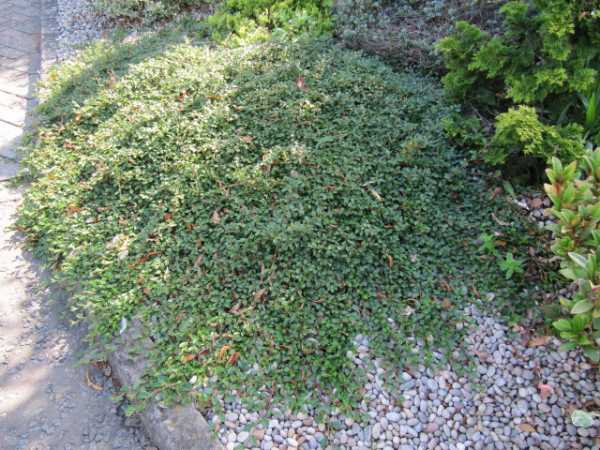

It reaches a height of up to 2 meters, is deciduous, has thin graceful branches.
Pressed cotoneaster
A shrub even shorter than the horizontal cotoneaster. Its height rarely exceeds 30 cm. It grows very slowly and requires shelter for the winter.
They have a lot in common, but differ in the color of the fruit. These varieties have very remarkable leaves: from the outside they are smooth and glossy, and from the bottom - grayish and "felt". These cotoneaster are sun-loving, frost-resistant, perfectly tolerate gas pollution and an excess of lime in the soil.
The most popular variety among deciduous shrubs. It reaches a height of up to 2 meters, its foliage is dense, of a beautiful dark green color, which in autumn acquires a lot of fiery shades from pale yellow to bright red. This plant is extremely unpretentious, perfectly sheared and is suitable for both single and group plantings. You can read more about it here.
Landing
Despite the fact that all cotoneaster is unpretentious, you will have to tinker a little with this variety. This plant is demanding on soil fertility, and practically indifferent to its moisture.
The optimal composition of the soil will be as follows: you need to make a mixture of sand, peat compost and sod in a ratio of 2: 1: 2. It is recommended to apply up to 300 g of lime per 1 m2 of land.
We invite you to familiarize yourself with: Planning and design of the site
For a horizontal cotoneaster, drainage is required: it will be enough to lay broken brick or gravel 10-15 cm thick on the bottom of the hole.
These plants do not require constant care. It is enough to pay attention to it several times a year, and it will develop perfectly.
Fertilizer Kemira universal
With the onset of the first warm days, you need to fertilize the soil. To do this, you can use the following compositions: add 20-25 g of urea to a bucket of water, or add 100 g of Kemira-universal per 1 m2 of soil.
Before flowering, and this is the last decade of May, you need to feed the plant in one of two ways: either add up to 15 g of potassium sulfate per 1 m2 of soil, or 60 g of granular superphosphate on the same volume of soil.
This drought-resistant plant should be watered no more than once a month. If the season is very hot, then you can do it once every 2 weeks.
Preparing the plant for wintering, the branches are bent down, mulched with peat or sprinkled with a layer of dry leaves.
The horizontal cotoneaster grows rather quickly and therefore requires regular pruning. This plant lends itself very well to forming, which is used with pleasure by gardeners in the process of decorating their garden.
To avoid damage to the cotoneaster by aphids and other pests, it should be periodically sprayed with insecticides and other insect control agents.
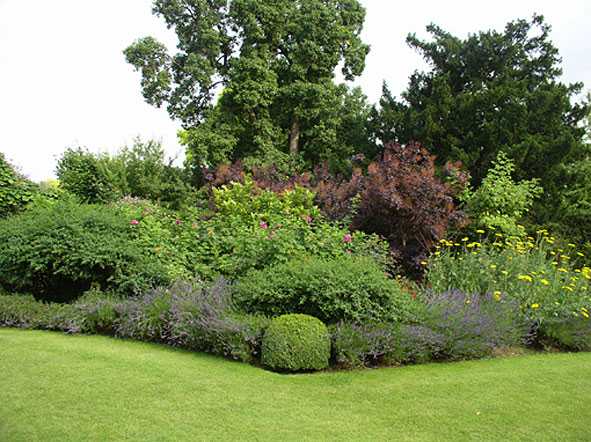

Do you want to do the drainage of the site with your own hands? We will tell you how.
The horizontal cotoneaster is a lush, undersized shrub with small green glossy leaves, which change color to a rich red closer to October. The homeland of this amazing plant is China. The horizontal cotoneaster, planting and caring for which will not cause much trouble, has some cultivation features.
This type of ornamental shrub is in demand by many landscape designers. The plant is indispensable for creating rocky gardens. The Coral Extravaganza variety is often used to strengthen slopes.
A vibrant cotoneaster hedge of this variety will beautify any garden or city park. Low shrubs with a crown that grows up to a meter wide are found in gardens and parks in different countries.
Often, a shrub with crimson berries and bright foliage is planted at the edge. The Coral Extravaganza variety is the central detail of the original compositions on a well-groomed lawn.
Details
The height of the shrub is up to half a meter. The pinnate-branched shoots are almost pressed to the ground.
Horizontal cotoneaster variety Coral extravaganza quickly reaches its maximum width. The crown grows a full meter, creating a beautiful "openwork veil"
The leaves are small, dark green. With the onset of autumn, the shrub turns purple. The rich color of the leaves and fiery red berries up to 5 mm in diameter adorn the site until late autumn. Some fruits in the lower part of the bush do not fall off even in winter.
The Coral Extravaganza variety loves light, tolerates arid conditions and gas pollution of city streets well. Prepare sandy or loamy soil before planting. Excessive moisture negatively affects the development of the plant.
To create dense hedges and spectacular borders, plant a horizontal cotoneaster on the site. This low, spreading shrub has taken root well in different regions of Russia. Provide the plant with a sufficient flow of light, regularly care for it - and your garden will be sunny for a long time.
Its bright red fruits enliven the dull landscape of late autumn, and group plantings of cotoneaster on the slopes and at the foot of buildings look very impressive.
You can mix different varieties of this plant, this will only intensify the emphasis on the unusualness of cotoneaster: their beautiful small leaves and dense climbing of branches.
Compositions from cotoneaster look great on the edges, well lit by the sun.You can use this plant for single plantings.
It is not recommended to plant a horizontal cotoneaster near water bodies, as it does not tolerate an excess of moisture.
It is worth mentioning that the horizontal cotoneaster is also used in bonsai, but this is a topic for a separate article.
Photos of both individual bushes and detailed photos of fruits and branches
How to care for a shiny cotoneaster
Caring for a brilliant cotoneaster will not give you much trouble, however, to grow a beautiful and strong plant that can become a real garden decoration, you should still take into account several basic requirements.
Demanding watering
Any type of cotoneaster has a high drought tolerance, therefore, even in a very dry summer, the shrub can easily do without watering. It is enough to water adult plants of the brilliant cotoneaster several times a season, bringing 8 liters of water under each bush. The main thing in this matter is to prevent waterlogging, because an excessive amount of moisture in the soil can destroy the cotoneaster.
On hot days, especially if the plant grows in dusty places, it can be periodically refreshed by washing away the dust from the foliage of the shrub with a stream of water. This is especially true when the hedge serves as a fence and is located on the border of the site.
Did you know? The berries of the brilliant cotoneaster, which, as we have already noted, are quite edible, are most often used in the preparation of tea drinks, as well as tinctures and wines. In general, the dietary properties of these fruits can be used to create sweets, marshmallows and gingerbread, which is especially valuable for diabetics.
How to fertilize a plant
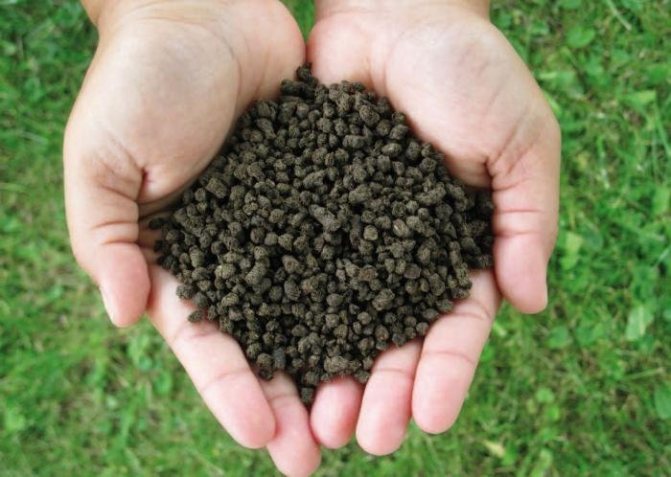

How quickly the brilliant cotoneaster will grow depends largely on the frequency of fertilization. So, if you want to get a beautiful and abundant crown, having achieved good growth during the season, then it is necessary to feed the shrub with nitrogen-containing fertilizers, and before direct flowering (around mid-May) under the bush, top dressing should be applied containing phosphorus and potassium (for example, superphosphate). Organic matter (humus or manure) should not be ignored. The slurry is diluted in water in a ratio of 1: 6, and when using poultry manure, 1 part of fertilizer should account for 10 parts of water. With the resulting composition, soil is shed during spring digging around the bush. In the same way, you can fertilize the soil with the help of dry complex compounds.
The basics of pruning cotoneaster brilliant
To create fences and decorative figures from a cotoneaster, molded pruning is mainly used, after which the shrubs grow rapidly, but retain their original shape. When using this method, all shoots are pruned by one third.
Important! The cotoneaster can be given absolutely any shape: a square, a ball, a cone, etc. However, you should start forming a crown only after the plant reaches a height of 60 cm (on average, this happens at two years of age).
To begin with, pinching the top is performed, which causes the active growth of new shoots. As soon as you get a crown with sufficient density, you can proceed to pruning.
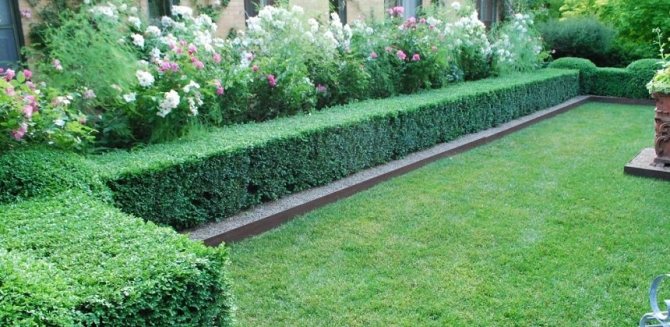

Regular hedges are especially sophisticated and attractive. Nevertheless, in order to get a neat and even living fence, cutting to any geometric shape, you need to have special trellis shears and a tightly stretched rope, although the most acceptable option is a ready-made template made of a wooden frame. You can create a similar frame or frame yourself: from the bars they make a shape in the form of a trapezoid, in which the upper part will be 10-15 cm narrower than the lower one. Anyway the form for the hedge must correspond to its purpose and height, taking into account the small margin left for the growth of shoots.
Before trimming, a rope is pulled between the two frames that are installed across the landings, adjusting the trimming surface. In the event that a large amount of pruning work is to be done, then it is better to use a special garden tool - a brush cutter.
For young plantings, the height of the annual pruning should be increased by 5-7 cm until the desired hedge size is reached. You do not need to be very zealous in removing or shortening the lower tier of branches and it is advisable to leave them 10-15 cm wider than the upper layer, which grows more actively, thereby causing partial darkening of the lower shoots.
Description and characteristics of species and varieties of cotoneaster
Types of cotoneaster
The horizontal cotoneaster belongs to the decorative species that represent the Pink family. In its natural environment, it is distributed mainly in China. This graceful plant in the wild is the best decoration for lifeless rocky slopes. The main distinguishing feature of the shrub lies in its name. This is primarily a creeping in a horizontal position, which is characterized by evergreen foliage.
The size of the plant is rather miniature, its height does not exceed 70 cm, and its width is more than 1.5 meters. The shoots of the shrub are rather branched and create a dense crown. Each shoot is covered with small and rounded leaves of a dark green color, which change to a characteristic purple hue towards autumn.
The flowering period for this species begins at the end of May and lasts for 3 weeks, while the shoots are covered with small, almost invisible paired or single flowers of a delicate pinkish-white hue. After flowering, bright red small fruits appear on the shrub, which in most cases can remain on the plant until the next spring.
Among the numerous representatives, the horizontal variegatus cotoneaster (Variegatus) is the most popular among gardeners. An adult plant is small in size, its height does not exceed 30 cm in height and 1.5 m in width. This shrub variety has gained particular popularity due to its amazing aesthetic colors in the fall.
The horizontal cotoneaster is a creeping shrub of the Pink family. It is a fast-growing, evergreen compact shrub, no more than 50 cm high.Its main characteristics include the following indicators:
- Shoots are pinnately branched, similar to a fish tail. They are located with each other in the same plane, "spread out" up to 1.5 meters wide.
- The leaves are dense, small, rounded, dark green.
- Flowers - inconspicuous, paired or single, bright pink with a red tint.
- Fruits are globular, bright red, about 5 mm in diameter.
general description
Representatives of the Pink family are represented by lush bushes with a dense crown formed by highly branching shoots. The horizontal cotoneaster is a native of China, which, with the arrival of winter, does not shed its foliage, continuing to decorate the site. The culture owes its name to the structure: the branches spread along the ground and do not exceed a height of 1 m. And the crown diameter can reach 2 m, allowing you to hide unsightly areas.
Advantages and uses
The horizontal cotoneaster in the garden has a fairly wide range of applications. The plant is recommended to be planted in rockeries, near retaining walls. Also, this shrub can be used as a lawn species. The creeping structure of the shoots allows him to completely cover the habitat and become the dominant species on it.
The main function of the plant is to completely fill the space of the lower or middle tier. The shrub is planted in large quantities or single plants. A hedge or a cotoneaster border has gained particular popularity. To do this, young plants are planted along the contour of the hedge at a distance of 30 cm from each other.


When a lonely plant is grown, a complex crown is formed from the shoots of a bush, which in its appearance can take on a different appearance. Such a composition in landscape design can be combined with any type of plants, which makes it possible to create unique landscaping areas. Also, this species is an ideal component of the "Japanese garden", with the help of shrubs they form characteristic compositions with decorative boulders.
Preliminary preparation
Before planting a cotoneaster, it is necessary to carry out preparatory procedures. The full-fledged growth of this culture depends on this. It is important to choose quality planting material and a suitable planting site. When choosing a horizontal cotoneaster seedling, the following nuances should be considered:
- This plant is presented in two forms: with pure green foliage and with a bordered white. Both forms look great in landscaping. If you purchase seedlings of both types, you can create a magnificent landscape drawing.
- It is better to purchase planting material in nurseries and specialized retail outlets.
- Before buying, you need to inspect the seedling carefully. There should be no signs of pests and diseases on its shoots and leaves. The container should be filled with moist, clean soil.
- You shouldn't buy a cotoneaster off-hand, especially if you don't know what it actually looks like.
When choosing a place for planting a cotoneaster, one should give preference to well-lit places. The plant also feels good in light partial shade. However, in this case, the foliage will have a less saturated hue. It is better if the cotoneaster is planted on a small hill. This will help to avoid stagnation at the roots of moisture.
This plant requires nutritious fertile soil. The soil should consist of peat, sand and turf. The site should first be well dug up and leveled.
Characteristics and features
In order to equip a cotoneaster bush in your garden, you will have to be patient and diligent. Despite the fact that this plant is unpretentious, planting it in open soil requires a lot of effort. The optimal period for this process is early spring.
Seat selection
The plant prefers places with diffused light or partial shade, the lack of light does not affect the decorative effect of the bush, therefore it develops safely at any intensity of solar radiation. However, the most aesthetically beneficial specimens develop exclusively in conditions of good lighting and the correct combination of garden tiers.
Soil is one of the first challenges you will have to face when planting a cotoneaster. Not in all conditions the bush will take well. The ideal solution would be to introduce a specially prepared substrate of sand, peat compost and sod, which is prepared in proportions of 2: 1: 2 into the hole before planting, it is also important to add lime to the soil at the rate of 300 g per 1 sq. M.
Tags: horizontal, design, cotoneaster, landscape
About
«Previous post
Follow-up care
It is very easy to care for a cotoneaster. It is because of this characteristic that it is often called the "plant for the lazy." However, to ensure decorativeness throughout the entire life cycle, standard agricultural cultivation measures should be observed. These include irrigation, fertilization, tillage, and integrated plant protection.
Watering
The cotoneaster has a powerful root system, which, after full development, is able to independently extract moisture even from a meter layer. However, before rooting, the plants are systematically moistened. Landmark - drying of the surface layer. Adult specimens are irrigated only during periods of severe drought. The cotoneaster responds well to sprinkling, which allows dust to be washed off the shoots, making it easier for the flora to breathe.
Owner reviews
The cotoneaster is my favorite plant in the country. A beautiful hedge complements the area and makes it well-tended. There are no difficulties in growing, which is very valuable.
Vika
For a long time I was going to arrange a hedge near my house, but there was no time for caring for rare plants. A friend advised me to grow a cotoneaster, and I agreed. Now I have no regrets. The shrub looks very attractive and does not require difficult maintenance.
Igor, 43 years old
If you have never cultivated ornamental plants before, start with a brilliant cotoneaster. Firstly, such a green space will allow you to learn the basic features of caring for ornamental shrubs. And secondly, it will be a great addition to landscape design on your site.
Svetlana, 34 years old,
How to do pruning correctly
This operation is best done in March, before the start of sap flow. To make the bushes look neat, you should remove all frozen, dried and growing branches inside the bush. In summer, the plants are pruned again, forming a beautiful crown. When performing this procedure, it should be remembered that no more than 1/3 of the length of the annual growth can be removed. In the second year after planting, the shoots are cut off by no more than ¼. In order to get a perfectly flat hedge, it is worth using a special wooden template or at least tightly stretched ropes.
If the owners want to achieve a pillow form of planting a cotoneaster, it should be pruned only from above, in the central part of the bush.
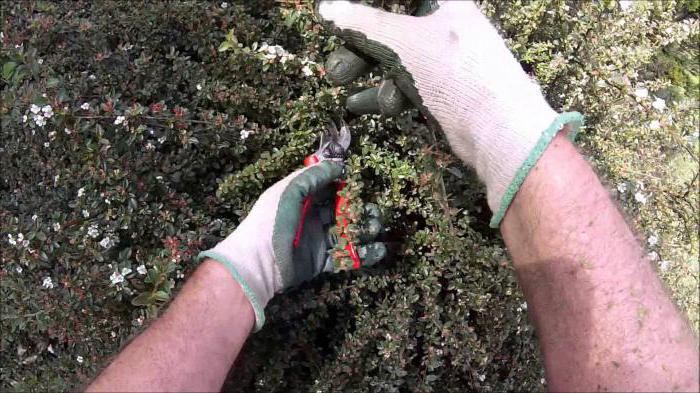

Diseases and pests
Among the most common pests should be highlighted:
- Aphids;
- Mole.
Aphids are found with shriveled and gradually drying out leaves... To destroy the pest, you should use drugs such as "Metaphos" and "Karbofos". And for prevention, the shrub is sprayed with nitrofen.


Aphid colony on the Cotoneaster bush
The moth leaves narrow passages on the leaves... For the destruction of moths, "Karbofos" and "Ammorphos" are used.
The most common disease is fusarium... This is a fungal infection. If found, it is required to destroy all affected shoots. If the lesion is severe, then it is better to transplant the shrub and disinfect the soil.
Varietal variety
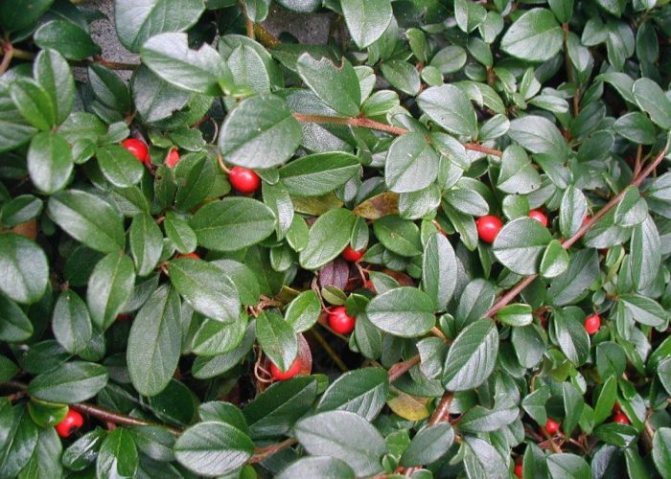

Cotoneaster Ordinary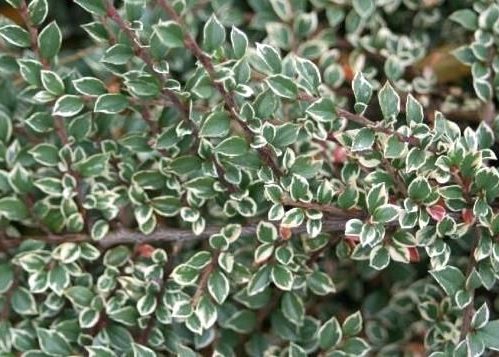

Variegatus
The horizontal cotoneaster and its varieties are very popular among gardeners because of their discreet decorativeness that can decorate the garden at any time of the year. The most famous varieties:
- variegatus... It features a white border that frames the leaves;
- perpusilus... This is the fastest growing variety among all the others;
- sahatilis... Very small leaves are located on the lying branches.
Versatility of the cotoneaster
Landscaping is the main application of the cotoneaster. Today, they create amazingly beautiful decorations for gardens, vegetable gardens, parks and city streets, which have been attracting attention for several months. The birds are also happy, because the fruits of some varieties of cotoneaster are an exquisite delicacy for them. Thus, the decorative component of the cotoneaster acquires not only picturesqueness, but also naturalness.
In an effort to achieve greater uniqueness and double the splendor rate when using a cotoneaster, it is recommended to combine several varieties together. Given their ability to germinate in groups, they can create more expressive beauty thanks to the distinctive features hidden in each of the cotoneaster varieties.
The cotoneaster can also be considered a useful plant, because its normalized use helps to get rid of a number of diseases of varying severity. Chronic gastritis, epilepsy, nervous disorders, jaundice and scabies are all successfully treated due to the unique properties of individual types of cotoneaster.
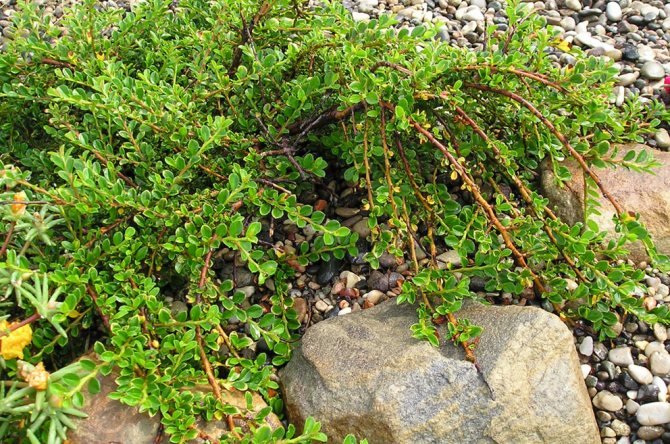

What to watch out for cotoneaster
Despite its resistance to all kinds of diseases and pests, you should regularly look closely at the foliage and shoots of the cotoneaster in order to remove damaged elements in time.
The first enemy of the cotoneaster is the green apple aphid. The first signs of infection: the leaves begin to wrinkle, and the shoots begin to bend. All this can lead to their drying out.
The second dangerous enemy of the cotoneaster is the apple white crumb moth. It contributes to the mining of the leaf, after which, patterned passages remain on it, which, although hardly noticeable, can cause many problems in the future.
You should also be wary of the cotoneaster mite, plum sawfly and scale insects. They are harmful not for all types of cotoneaster, but only for some of its species. If you do not pay attention to them in time, foliage and branches are doomed to dry out.
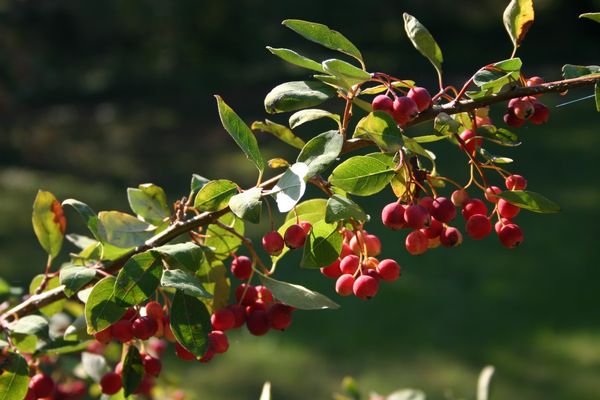

How to water
Shrub cotoneaster horizontal - drought-resistant. Therefore, the soil underneath is usually not moistened. The natural moisture present in it is quite enough. The cotoneaster can lose its decorative effect only in a very dry, windy summer. In such weather, it is still necessary to water it. This is done once or twice a month, spending about eight liters of water per plant. An exception to the general rule is the year of planting. At this time, the cotoneaster should be watered more often.
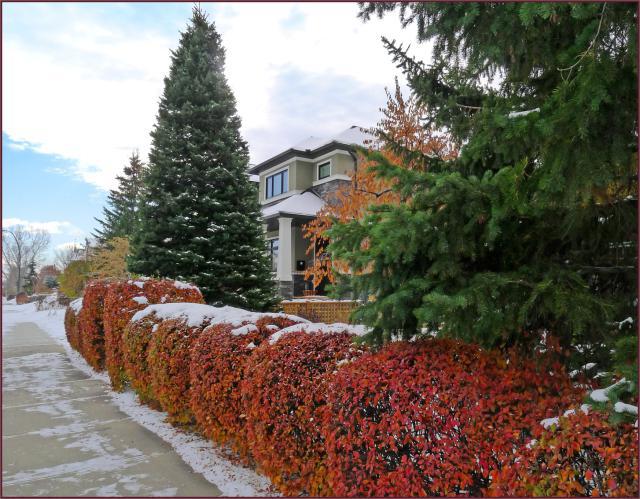

Some time after watering, the bushes weed and loosen the soil under them to a depth of no more than 10-15 cm.
How to keep a cotoneaster in winter
Even in regions with a sharply continental climate, the cotoneaster can tolerate frost under cover very well. In order to protect the plant from freezing, its branches should be pressed to the ground and covered with peat in a layer of 5 cm. In this case, even in the coldest weather, flower buds will not be frozen near the bushes. In those regions where there is a lot of precipitation in winter, cotoneaster is usually just covered with snow.
In spring, the plant should be covered with spruce branches to protect it from too bright sunlight. The cotoneaster is gradually taught to summer lighting, removing the spruce branches initially only on cloudy days.
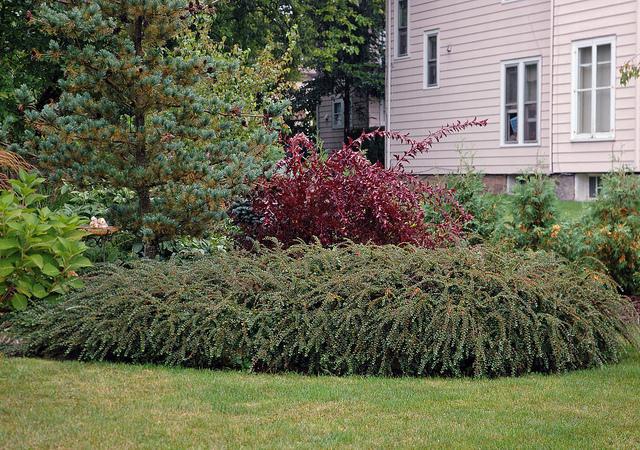

Plant portrait
Cotoneaster (Cotoneaster) is part of the genus of the same name of the Rosaceae family. In total, this genus includes more than 80 species, which are represented by deciduous or evergreen shrubs of various heights (from 0.3 to 3-5 meters). In our country, there are more than 40 species of this plant.
A large number of simple leaves of a dense green color, located alternately (one after another) on the branches, almost completely cover the bushes. They attach to the shoots with short petioles. With the onset of the autumn months, the leaves turn red.
The flowers of the cotoneaster are pinkish or white, solitary or united in small inflorescences such as a multi-flowered raceme or scutellum. Spherical shiny fruits of red or black color with several seeds inside are kept on the bushes until the very deepest autumn. They give the bushes a spectacular look that lasts for a long time.
How is a cotoneaster planting carried out? What kind of care does he need? What subtleties of growing a cotoneaster do you need to know? Read on for more details.
Pest control
The horizontal cotoneaster, planting and caring for which are extremely simple procedures, also has the advantage that it is almost never affected by insects and fungi. However, sometimes the plants become infected, and the owners have to take measures to save the green pets. For example, apple aphids can cause great harm to the cotoneaster. The most effective remedy against it is pepper tincture. To prepare it, you need to mix the gruel of two finely grated chili with 2 liters of soapy water.
Also, sometimes the cotoneaster is affected by the crumbled apple moth. To get rid of it, you should spray the plants with a 10% solution of karbofos.
Another common pest of this crop is the cotoneaster mite.In case of damage by these insects, the plants should be treated with Actellic according to the instructions.
Application in landscape design
A common practice is to plant a horizontal cotoneaster to decorate alpine slides and rocky gardens.
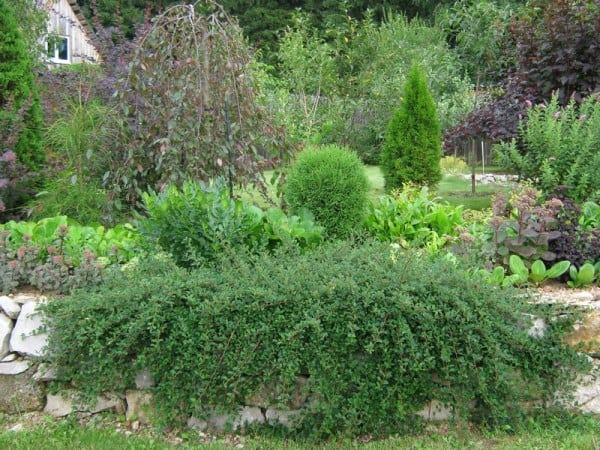

The plant is used with great success for decorating walls and fences.


The shrub looks very impressive in a variety of compositions made up of dwarf coniferous trees and flowering low-growing bushes. The combination with variegated crops is especially elegant.


The plant can also be used for single plantings.
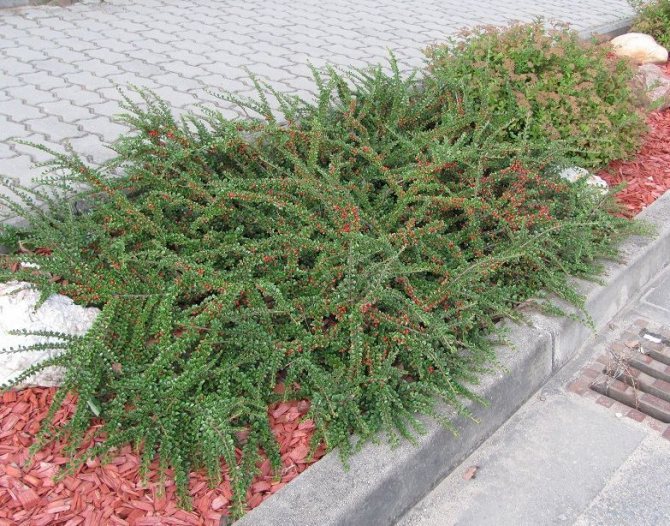

A good shrub when drawing up a hedge, since it is very malleable in giving it different shapes when pruning.
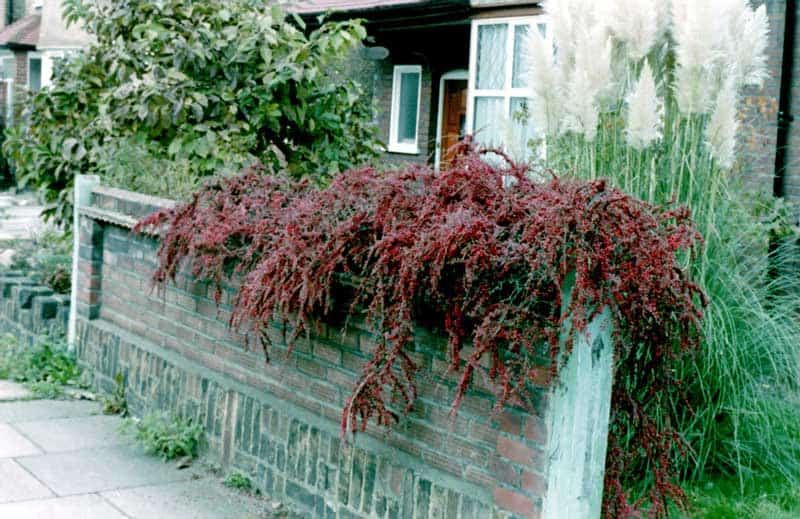

When composing rockeries, a horizontal cotoneaster is simply irreplaceable, its neighborhood emphasizes the beauty of a rocky slope or flower beds with various plantings.
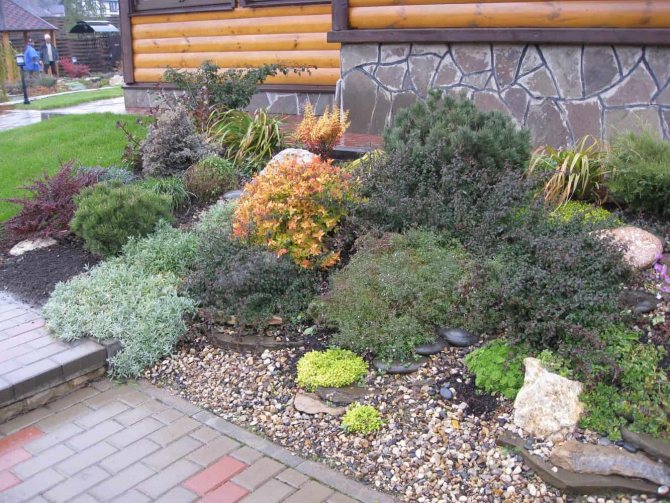

It is as if on purpose created in order to combine a variety of drought-resistant crops.
With the help of the horizontal cotoneaster, you can also design single compositions, giving him the main role.
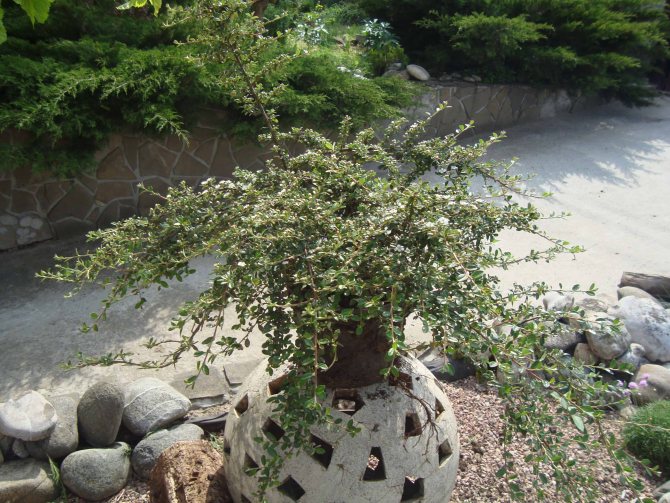

The unobtrusive beauty of the cotoneaster is capable of changing colors throughout the growing season. The bright green leaves are gradually replaced by a dark red hue, pink flowers turn into fiery scarlet berries.
Each time the garden takes on new shades, transforming and captivating with beauty. such a bush is indispensable as a tapeworm on the rocky slopes of gardens, because the spreading branches look very harmonious in combination with stone, ceramics or bronze.
When decorating a mixborder, this shrub looks very organic. If you add the same unpretentious plants to the composition, you get a composition that requires minimal maintenance, capable of pleasing with its beauty for a long time. For this purpose, you can plant juniper and Cossack ivy.
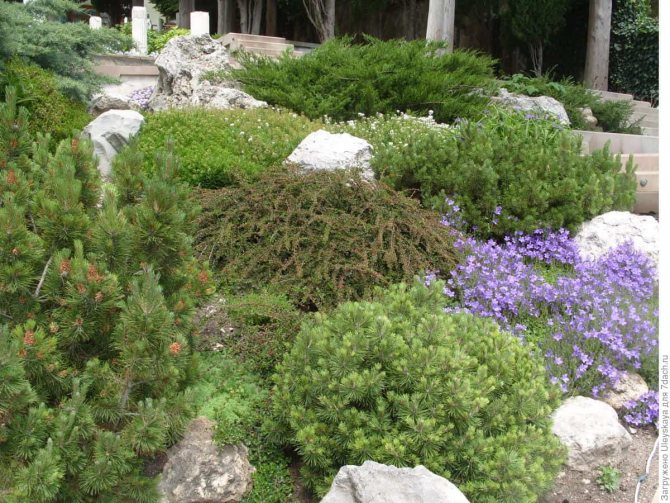

Since the bush reacts well to a haircut, it is possible with its help to form flower beds of various shapes.
It is also quite possible for a horizontal cotoneaster to brighten up the shady edges near high plantings. A deciduous garden will literally be transformed by the bright colors that this bush can add in the autumn and winter, when the trees are bare.
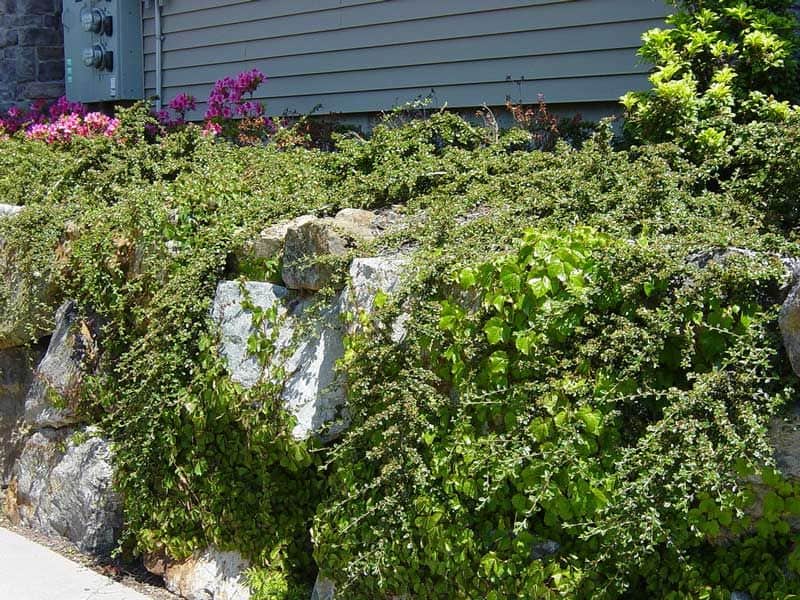

Using this plant in combination with other species, you can create very beautiful compositions for decorating walls and fences. Here the emphasis is on the decorativeness of dense branches with bright foliage and flowers.


With the arrival of autumn days, berries look especially bright against the background of the light material of the walls and stone. Such a composition will become the center of attention for a long time.
The cotoneaster is horizontal, unpretentious and malleable in formation, very well suited for decorating garden plots



